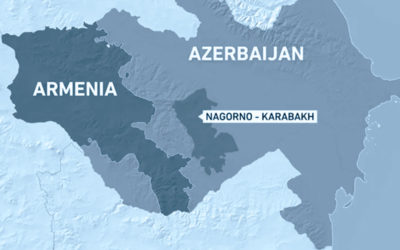Operationalising resilience: an example from Ukraine
21 November 2017
Russia’s illegal annexation of Crimea in 2014 and its subsequent invasion of eastern Ukraine led to a series of attacks against Ukraine. These have included cyber-attacks, fake news, economic pressure, terrorist attacks, as well as an all-out military conflict. Given that eastern Ukraine was at the centre of these attacks, its civil society developed its own resilience strategy to minimise the impact of non-military hybrid threats. This experience provides valuable lessons for Europe in general.
Ukraine’s response to Russian hybrid warfare
The concept of ‘resilience’ has traditionally been used in the areas of development and risk management. The European Union’s (EU’s) 2016 Global Strategy defined resilience as a concept that encompasses the ability of states, societies, communities and individuals to transcend a crisis while maintaining national economic and social development, and adapting to the changing environment under the pressure of continuous threats.
European states, both EU and non-EU ones, face many common security challenges such as terrorism, cyber threats, fake news, political and economic pressure, and military sabre-rattling. Given that military force is not often the most appropriate and effective way of addressing such hybrid threats, a resilience strategy can and should be deployed to strengthen the state’s capacity to deal with them.
Ukraine has become a testing ground for Russia’s unconventional tactics. It is also an easy target due to internal systemic weaknesses caused by corruption, dysfunctional institutions, and a fragmented civil society. By means of disinformation, operations of influence and subversion, Russia annexed Crimea without an open military intervention. It also localised a static, low-level conflict in eastern Ukraine, i.e. masked “People’s Republics’” puppet states as a product of civil war where Russia obscures its involvement to a secondary role.
Ukraine has become a testing ground for Russia’s unconventional tactics.
Following the annexation of Crimea, a Russian disinformation operation was launched to discredit the Ukrainian government and institutions in the eyes of the country’s citizens. At first, Ukraine faced significant difficulties in responding to the way Russia was challenging the perception of national identity, values, and history. More specifically, there was a dramatic shortage of the resources required to protect the country’s military, diplomatic, media and home fronts.
The most effective deterrent against hybrid threats proved to be societal resistance. A non-violent local civilian defence operation began. This included civilian groups debunking fake news with the extremely successful website StopFake, countering cyber-attacks, forming humanitarian aid volunteer groups, volunteer reform teams in government agencies and local councils, and volunteer civilian patrol and rescue teams.
Although this response had a positive impact, it was chaotic and needs sustained support to become part of a resilience strategy facing a continuous level of threat. The key to developing an effective strategy is to rethink the nature of the threat and decentralise the response to the level of communities and individuals.
A bottom up approach to resilience
If we understand hybrid warfare as a complex set of interconnected threats and forceful means waged to further political motives we no longer limit threats to traditional kinetic operations. In fact, hybrid threats have made traditional state borders irrelevant. It is no longer only the protection of borders that guarantees a nation’s security but also its home front.
To fortify the home front, European states need to challenge the traditional top-down institutional approach towards security and development planning. The Ukrainian experience illustrates the difficulties in making domestic resilience work in practice.
Engagement between government institutions and civil society remained inefficient, creating gaps between the needs and the expectations of the population on the one hand, and the capacities and resources of the authorities on the other hand. Those gaps indicated the state of resilience as well as the areas vulnerable to hybrid attacks.
National resilience is a continuous process of developing and improving knowledge of the changing needs and security threats on local and national levels.
The nexus between national security and resilience is rooted in individuals’ attitudes toward leadership and institutions. To operationalise resilience, it is necessary to monitor levels of trust and preparedness as key indicators of existing gaps between the population, civil society and government institutions.
The EU’s Global Strategy correctly points out that “when the ‘centre’ is broken, acting only from top-down has a limited impact.” It is much more difficult for an external force to disrupt personal and organisational networks built by both the private and public sector. This reality is what makes bottom up organisations key factors in enhancing resilience.
The way forward
National resilience is a continuous process of developing and improving knowledge of the changing needs and security threats on local and national levels. The EU’s objective to help states and societies build their resilience is limited to financial and knowledge transfers (monitoring, training, advising).
To guarantee local ownership, the EU should engage at the level of an actor’s capabilities. However, this creates practical challenges. In reality, resilience building means going to distant regions of the EU’s partner countries such as eastern Ukraine. The cities of Kramators’k, Sieverodonets’k, and Mariupil are at the heart of an effort to build effective resilience against disinformation and military attacks. It is clear that an effective EU response would require facilitating partnership between the state and civil society in local communities.
Such ambition should be met with clear understanding how to choose the local partners and monitor fund distribution. All investments should come with the tag of local ownership and responsibility. Aside from all of these challenges, the EU’s presence in Ukrainian communities would allow its member states to learn on the ground the most practical tools to counteract hybrid threats and improve national resilience in their home countries.
ENJOYING THIS CONTENT?





















